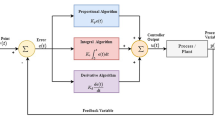Abstract
Model predictive control (MPC) frequently uses online identification to overcome model mismatch. However, repeated online identification does not suit the real-time controller, due to its heavy computational burden. This work presents a computationally efficient constrained MPC scheme using nonlinear prediction and online linearization based on neural models for controlling air–fuel ratio of spark ignition engine to its stoichiometric value. The neural model for AFR identification has been trained offline. The model mismatch is taken care of by incorporating a PID feedback correction scheme. Quadratic programming using active set method has been applied for nonlinear optimization. The control scheme has been tested on mean value engine model simulations. It has been shown that neural predictive control with online linearization using PID feedback correction gives satisfactory performance and also adapts to the change in engine systems very quickly.


















Similar content being viewed by others
Abbreviations
- H u :
-
Fuel lower heating value (kJ/kg)
- EVO:
-
Exhaust valve opening BBDC
- IVO:
-
Intake valve opening BTDC
- I :
-
Engine inertia (kg m2)
- N :
-
Crankshaft speed (rpm)
- P f :
-
Frictional power (kW)
- P p :
-
Pumping power (kW)
- P b :
-
Load power (kW)
- P man :
-
Manifold pressure (bar)
- P amb :
-
Ambient pressure (bar)
- R :
-
Gas constant
- T amb :
-
Ambient temperature (K)
- T delay :
-
Transport delay (s)
- T EGR :
-
EGR temperature (K)
- T man :
-
Manifold temperature (K)
- V man :
-
Manifold volume (m3)
- V d :
-
Engine displacement (l)
- e v :
-
Volumetric efficiency
- k b :
-
Loading factor
- \( \dot{m}_{\text{at}} \) :
-
Air mass flow past the throttle (kg/s)
- \( \dot{m}_{\text{ap}} \) :
-
Air mass flow into the intake port (kg/s)
- \( \dot{m}_{\text{EGR}} \) :
-
EGR mass flow (kg/s)
- \( \dot{m}_{\text{f}} \) :
-
Fuel flow into intake port (kg/s)
- \( \dot{m}_{\text{ff}} \) :
-
Fuel film mass flow (kg/s)
- \( \dot{m}_{\text{fi}} \) :
-
Injected fuel mass flow (kg/s)
- \( \dot{m}_{\text{fv}} \) :
-
Fuel vapour mass flow (kg/s)
- n :
-
Crankshaft speed (krpm)
- n cyl :
-
Number of cylinders
- η i :
-
Indicated efficiency
- α:
-
Throttle angle (degrees)
- θ:
-
Spark advance (degrees)
- θmbt :
-
MBT spark advance (degrees)
- λ:
-
Relative air/fuel ratio
- τf :
-
Fuel evaporation time constant (s)
- γ:
-
Ratio of specific heats for air (1.4 for air)
References
Alippi C, Russis C, Piuri V (2003) A neural-network based control solution to air–fuel ratio control for automotive fuel-injection systems. IEEE Trans Syst Man Cyber-Part C: Appl Rev 33:259–268
Shiraishi H, Ipri LS, Cho D (1995) CMAC neural network controller for fuel injection systems. IEEE Trans Control Syst Technol 3:32–38
Manzie C, Palaniswami M, Ralph D, Watson H, Xiao Y (2002) Model predictive control of a fuel injection system using a radial basis function observer. ASME J Dyn Syst Meas Control 124:648–658
Wang SW, Yu DL, Gomm JB, Page GF, Douglas SS (2006) Adaptive neural network model based predictive control for air-fuel ratio of SI engines. Eng Appl Artif Intell 19:189–200
Hendricks E, Sorenson SC (1990) Mean value modelling of spark ignition engines. SAE technical paper no. 900616
Chevalier A, Muller M, Hendricks E (2000) On the validity of mean value engine models during transient operations. SAE technical paper no. 2000-01-1261
Hendricks E, Engler D, Fam M (2000) A generic mean value engine model for spark ignition engines. In: 41st simulation conference, SIMS 2000, DTU, Lyngby, Denmark
Hendricks E (2001) Isothermal versus adiabatic mean value si engine models. In: 3rd IFAC workshop on advances in automotive control. Karlsruhe Germany
Hendricks E, Chevalier A, Jensen M, Sorenson SC, Trumpy D, Asik J (1996) Modelling of the intake manifold filling dynamics, SAE technical paper no. 960037
Hendricks E, Vesterholm T (1992) The analysis of mean value SI engine models, SAE technical paper no. 920682
Hendricks E, Jensen M, Kaidantzis P, Rasmussen P, Vesterholm T (1993) Transient A/F ratio errors in conventional SI engine controllers, SAE technical paper no. 930856, in Special Publication SP-955
Chevalier A, Vigild C, Hendricks E (2000) Predicting the port air mass flow of SI engines in air/fuel ratio control applications, SAE technical paper no. 2000-01-0260
Berggren P, Perkovic A (1996) Cylinder individual lambda feedback control in an SI engine, Master’s Thesis. Linkopings University
Nørgaard M, Ravn O, Poulsen NL, Hansen LK (2000) Neural networks for modelling and control of dynamic systems, Springer, ISBN 1-85233-227-1
Lawrynczuk (2007) A family of model predictive control algorithms with artificial neural networks. Int J Appl Math Comput Sci 17(2):217–232
Hassibi B, Stork DG, Wolff GJ (1993) Optimal brain surgeon and general network pruning. In: proceedings, international conference neural networks
Arsie I, Pianese C, Sorrentino M (2006) A procedure to enhance identification of recurrent neural networks for simulating air–fuel ratio dynamics in SI engines. Eng Appl Artif Intell 19:65–77
Cutler R, Ramaker B (1980) Dynamic matrix control-a computer control algorithm. In: proceeding joint automatic control conference, San Francisco
Clarke DW, Mohtadi C, Tuffs PS (1987) Generalized predictive control-I. The basic algorithm. Automatica 23(2):137–148
Rao SS (2005) Engineering optimization. New Age International Publishers, ISBN: 81-224-1149-5
Gill PE, Murray W, Wright MH (1981) Practical optimization. Academic Press, ISBN 0-12-283952-8
Ogata K (2006) Modern control engineering. Prentice Hall India, ISBN 81-203-2045-X
Author information
Authors and Affiliations
Corresponding author
Rights and permissions
About this article
Cite this article
Saraswati, S., Chand, S. Online linearization-based neural predictive control of air–fuel ratio in SI engines with PID feedback correction scheme. Neural Comput & Applic 19, 919–933 (2010). https://doi.org/10.1007/s00521-010-0419-z
Received:
Accepted:
Published:
Issue Date:
DOI: https://doi.org/10.1007/s00521-010-0419-z




